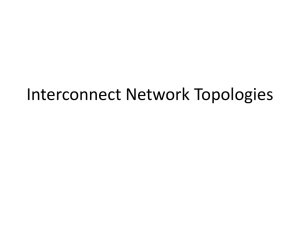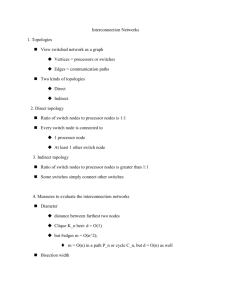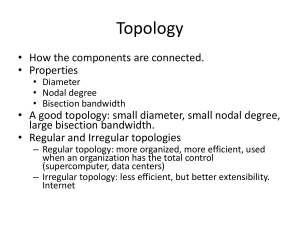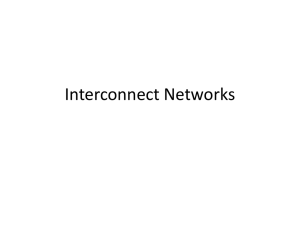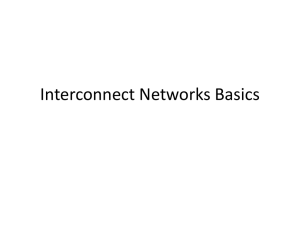Interconnect Networks
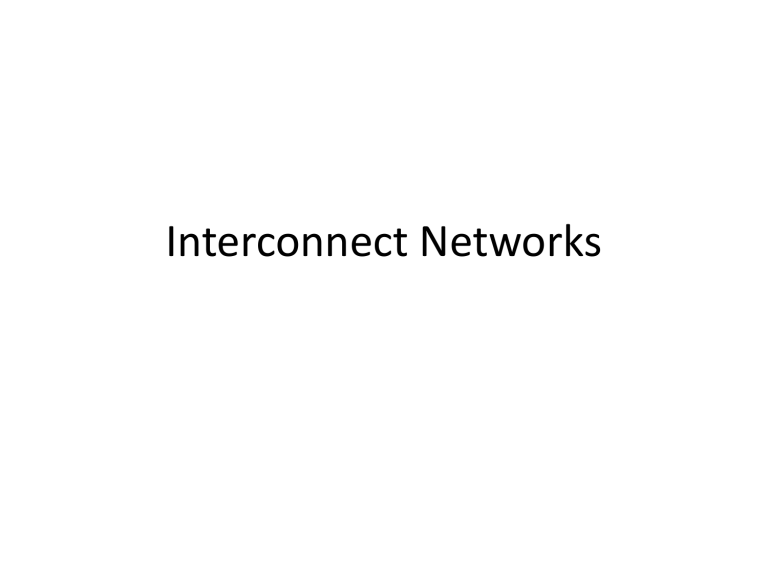
Interconnect Networks
Generic scalable multiprocessor architecture
• On-chip interconnects (manycore processor)
• Off-chip interconnects (clusters of servers)
• Network characteristics: bandwidth and latency
Scalable interconnection network
• At the core of parallel computer architecture
• Requirements and trade-offs at many levels
– Still little consensus at this time
• Interactions across levels (e.g. network level optimizations may conflict with messageing level optimizations).
• Workload
• Performance metrics
• Need holistic understanding
Network components
• Network interface (card)
• Communication between a node and the network
• Link
• Bundle of wires and fibers that carry signals
• Switches
• Connects a fixed number of input channels to a fixed number of output channels.
• In this community, switches may also have the router functions.
Switch
The cross-bar can realize a communication from any input port to any output port.
Cross-bar functionality – all permutations can be realized simultaneously i n p t u
3
4
1
2
1 2 3 4 output
A 4x4 cross-bar
3
4
1
2
1 2 3 4
(1,2, 3, 4)->
(3, 1, 2, 4)
3
4
1
2
1 2 3 4
(1,2,3,4)->
(4,3,2,1)
Permutation: (1, 2, 3, 4) -> (3, 1, 2, 4)
A communication pattern where each source happens once, each destination happens once.
Switch example: 24-port 1Gbps
Ethernet switch
• 24 input ports and 24 output ports – each
Ethernet jacket has one input port and one output port.
• All 24 machines can send and receive simultaneously.
switch
Ethernet card machine
Alternatives to cross-bars
• A question: why buffers when we can always do permutation?
• An N x N cross bar has O(N^2) cross points
(on/off switches).
– Not scalable, expensive
• An alternative for low end switches: bus and memory
– When bus and memory is fast enough, moving data between input and output ports are like memory copy in a typical computer.
Bus and memory alternative to crossbar
• Realizing (1, 2, 3, 4) -> (4, 3, 2, 1)
– Read from input port 1 to memory A
– Read from input port 2 to memory B
– Read from input port 3 to memory C
– Read from input port 4 to memory D
– Run forwarding logic (find out the output ports)
– Write A to output port 4
– Write B to output port 3
– Write C to output port 2
– Write D to output port 1
Bus and memory alternative to crossbar
• A typical northbridge bandwidth is a few
GBps. Let us assume the bandwidth is 4GBps, how many ports can the northbridge support in 100Mbps Ethernet swithes?
• This is why it can only used in low end switches!
Another alternative: multistage interconnection network
• Realize all permutations without controlling
O(N^2) cross-points.
– Clos networks, Benes networks
Characteristics of a network
• Topology (what)
– Physical interconnection structure of the network graph.
– Physically limits the performance of the networks.
• Routing algorithm (which)
– Restricts the set of paths that messages can follow.
• Switching strategy (how)
– How data in a message traverses a route (passing routers)
• Flow control mechanism (when)
– When a message or portions of it traverse a route
– What happens when traffic encountered
Topology
• How the components are connected.
• Important properties
• Diameter: maximum distance between any two nodes in the network (hop count, or # of links).
• Nodal degree: how many links connect to each node.
• Bisection bandwidth: The smallest bandwidth between half of the nodes to another half of the nodes.
• A good topology: small diameter, small nodal degree, large bisection bandwidth.
Topology
• Regular topologies
– Nodes are connected with some kind of patterns.
• The graph has a structure.
– Nodes are identified by coordinates.
– Routing can usually pre-determined by the coordinates of the nodes.
• Irregular topologies
– Nodes are connected arbitrarily.
• The graph does not have a structure, e.g. internet
• More extensible in comparison to regular topology.
– Usually use variations of shortest path routing.
Linear Arrays and Rings
Linear array
Ring (torus)
Short wire torus
Diameter = ?, nodal = ? Bisection bandwidth = ?
Describing linear array and ring
• Array: nodes are numbered from 0, 1, …, N-1
– Node i is connected to node i+1, 0<=i<=N-2
• Ring: nodes are numbered from 0, 1, …, N-1
– Node I is connected to node (i+1) mod N, for all
0<=i<=N-1
Multidimensional Meshes and Tori
• d-dimensional array/torus
• N = k_{d-1} x k_{d-2} x … x d_0
• Each node is described by a d-vector of coordinate
• Node (i_{d-1} x i_{d-2} x …x d_0) is connected to
???
More about multi-dimensional mesh and tori
• d-dimension k-ary mesh (torus)
– Each node is described by a d-vector of coordinates.
• The value of each item in the vector is between 0 and d_i-1.
– Diameter = ?
– Nodal degree = ?
– Bisection bandwidth = ?
Hypercubes
• Also call binary n-cubes. # of nodes = N = 2^n
• Each node is described by its binary representation.
• There is a link between two nodes whose binary representations differ by one bit.
• Diameter=? Nodal degree = ? Bisection bandwidth = ?
K-ary n-cube (n-dimensional, k-ary mesh/torus)
• Extended from binary (hypercube) to k-ary
• Each dimension has k elements, n dimensions
• Each node is identified by a k-based number (n digits).
– Dimension order routing
4-ary 0-cube
4-ary 1-cube
4-ary 2-cube
4-ary 3-cube
Trees
• Fixed degree, log(N) diameter, O(1) bisection bandwidth.
• Routing: up to the common ancestor than go down.
Irregular topology
• Irregular topology does not any special mathmetic properties
– Can be expanded in any way.
– No easy way for routing: routes need to be computed like in the Internet.
• Routes can usually be determined in a regular network by using the coordinates of the source and destination.
Direct and indirect networks
• All the previously discussed networks are direct networks in that the compute nodes are directly attached to the nodes in the topology.
– An example mesh system.
Each switch is a 5x5 switch
Indirect networks
• Compute nodes are not directly attached to each switch, but are rather attached to the whole network.
– Using a central interconnect to connect all compute nodes
– The network emulate the cross-bar switch functionality.
Fully connected network
• Different organizations:
– Connected by one switch (crossbar switch), connecting all nodes, connected with a crossbar.
• All permutation communication (each node sends one message and receives one message) can be realized.
Multistage network
• Try to emulate the cross-bar connection.
– Realizing permutation without blocking
– Using smaller cross-bar(2x2, 4x4) switches as the building block. Usually O(Nlg(N)) switches (lg(N) stages.
Multi-stage networks examples
(a) An 8-input butterfly network (b) An 8-input Benes network
• Butterfly network is blocking. There exist some permutation that results in link contention.
• Benes network is non-blocking. If the permutation is known a prior, it can always be realized without link contention.
Clos Network
• Three stages: ingress stage, middle stage, and egress stage
– Ingress/egress stage has r n X m switches
– Middle stage has m r X r switches
– Each switch at ingress/egress stage connects to all m middle switches (one port to each switch).
Clos Network
• Clos network is nonblocking when m>=2n-1.
Fat-Trees
• Fatter links (really more of them) as you go up, so bisection BW scales with N
– Not practical, root is an NxN switch
Practical Fat-trees
• Use smaller switches to approximate large switches.
– Connectivity is reduced, but the topology is not implementable
– Most commodity large clusters use this topology. Also call constant bisection bandwidth network (CBB)
Clos network and fat-tree (folded
Clos)
A generic 3-stage Clos network
A generic 2-level fat-tree
(folded Clos)
Physical constraint on topologies
• Number of dimensions.
– 2 or 3 dimensions
• Can be layout physically
• Short wires, easy to build
• Many hops, low bisection bandwidth
– >=4 dimensions
• Harder to build, longer wires
• Fewer hops, better bisection bandwidth
– K-ary n-cubes provide a good framework for comparison.
